Chuck D. Bones
Circuit Wizard
You have the pots wired correctly.
I have an updated design that moves the VOLUME pot between U1.1 and the TREBLE pot. This has two advantages:
1. It improves the headroom. At high DRIVE and MID settings, U1.2 could saturate. With the VOLUME control ahead of U1.2, we can back off on the VOLUME as req'd to avoid saturation.
2. It reduces the output impedance.
Note the various component value changes.

I have an updated design that moves the VOLUME pot between U1.1 and the TREBLE pot. This has two advantages:
1. It improves the headroom. At high DRIVE and MID settings, U1.2 could saturate. With the VOLUME control ahead of U1.2, we can back off on the VOLUME as req'd to avoid saturation.
2. It reduces the output impedance.
Note the various component value changes.










